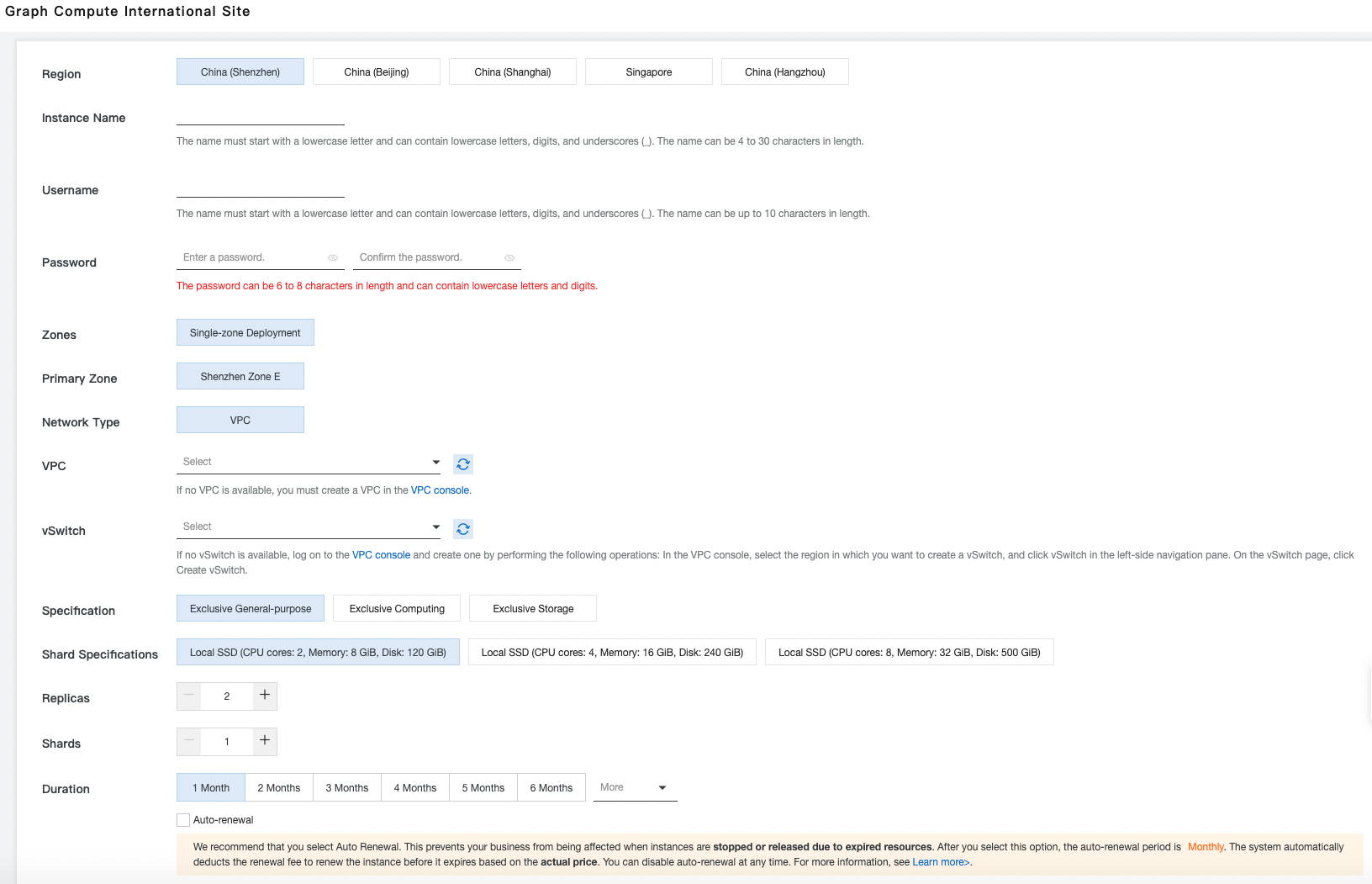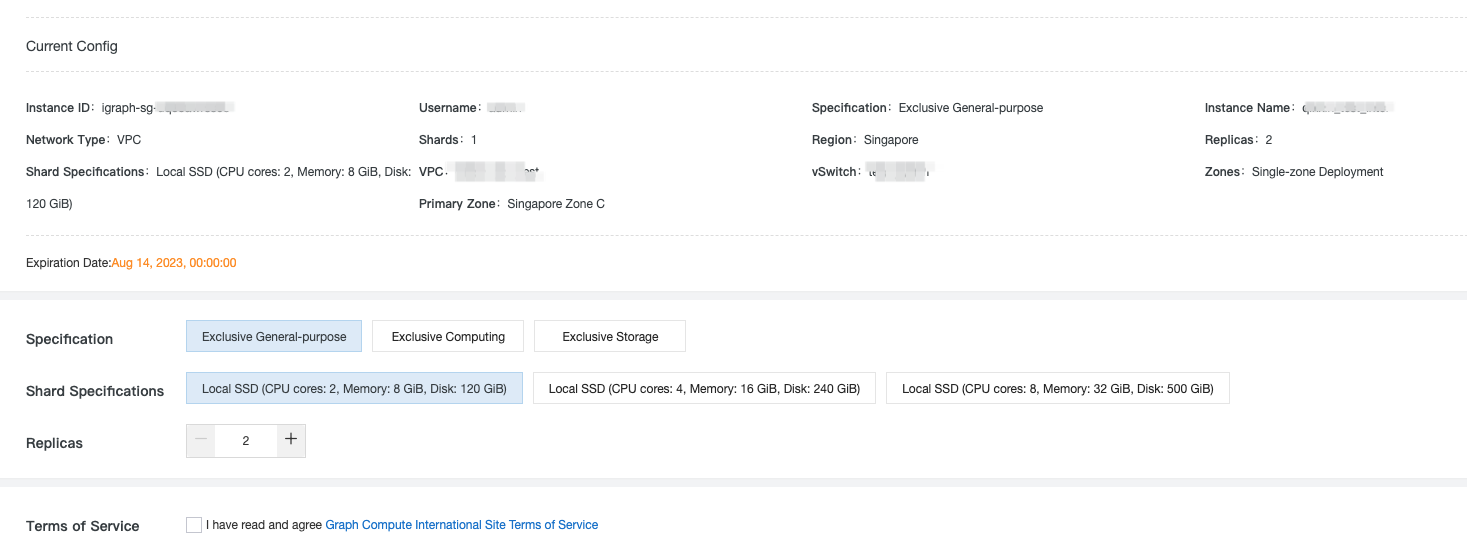Graph Compute は、コンピュータータイプ、ストレージタイプ、コモンタイプを含む、Exclusive タイプのインスタンスをパブリックプレビュー段階で提供しています。
Graph Compute インスタンスの作成
1. Graph Compute コンソール にログオンします。
2. 左側のナビゲーションペインで、[インスタンス] をクリックします。 [インスタンス] ページで、[作成] をクリックします。次に、購入ページが表示されます。サブスクリプション課金方式のみがサポートされています。

3. パラメーターを設定します。次の表にパラメーターを示します。
パラメーター | 説明 |
リージョンとゾーン | Graph Compute インスタンスを作成するリージョン。インスタンスの作成後は、リージョンを変更できません。
|
ネットワークタイプ |
|
VPC | インスタンスを作成する VPC 。使用可能な VPC がない場合は、作成します。詳細については、「VPC の作成と管理」をご参照ください。 |
vSwitch | 選択したゾーンの VPC 内でインスタンスを接続する vSwitch 。選択したゾーンの VPC に vSwitch が作成されていない場合は、作成します。詳細については、「vSwitch の作成と管理」をご参照ください。 |
シャード数 | インスタンスのシャード数。データは、インスタンス内のデータシャードに分散されます。 |
レプリカ数 | レプリカの数。Exclusive タイプのインスタンスは Cluster Edition です。デフォルト値は 2 です。ビジネス要件に基づいて値を増やすことができます。 |
シャードの仕様 | シャードの仕様。各仕様には、対応するメモリ設定、CPU 設定、およびディスクサイズがあります。 |
ユーザー名 | iGraph エンジンへのアクセスに使用するユーザー名。Graph Compute SDK が権限を確認するには、ユーザー名とパスワードを指定する必要があります。 |
パスワード | iGraph エンジンへのアクセスに使用するパスワード。Graph Compute インスタンスの他の設定を完了した後に、パスワードを設定できます。インスタンスの詳細ページでパスワードを変更できます。 |
インスタンス名 | インスタンスの名前。インスタンスの識別と管理に使用されます。 |
サブスクリプション期間 | インスタンスのサブスクリプション期間。サブスクリプション課金方式を選択した場合は、期間と自動更新設定も指定する必要があります。 |
Graph Compute インスタンスの管理
[インスタンス] ページですべての Graph Compute インスタンスに関する基本情報を表示します。
インスタンス ID / 名前:インスタンスの ID と名前。

ステータス:インスタンスのステータス。
次のセクションでは、インスタンスの作成ステータスについて説明します。
作成中:インスタンスの作成後、システムはインスタンスのリソースを適用しており、インスタンスは初期化されています。
インスタンスのデプロイ中:インスタンスはデプロイされています。
初期化済み:インスタンスのテーブルがデプロイされており、インデックスが作成されています。
失敗:インスタンスとテーブルの初期化に失敗しました。
次のセクションでは、インスタンスのランタイムステータスについて説明します。
実行中:テーブルとインスタンスは実行中です。
凍結:インスタンスは、支払いの遅延により凍結されています。インスタンスに対する操作を実行することはできません。
リリース済み:インスタンスはリリースされています。
タイプ:インスタンスのサーバー仕様。
有効な値:common、computer、storage
課金方式:課金方式とリリース時間。Graph Compute は、サブスクリプション課金方式のみをサポートしています。
Graph Compute インスタンスに対する操作を実行します。
詳細
[詳細] をクリックします。次に、インスタンスの詳細ページが表示されます。インスタンスの基本情報、仕様、およびデータを表示できます。
スケーリングと仕様の変更
レプリカの数とシャードの仕様を変更できます。

更新:インスタンスを更新できます。
短期更新:7 日と 15 日
中期更新:1 か月から 6 か月
長期更新:1 年
